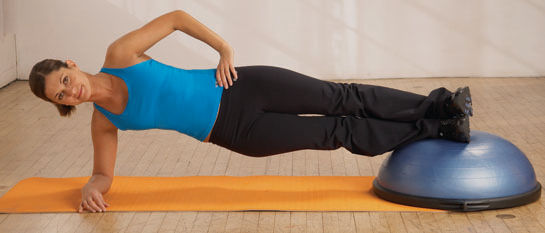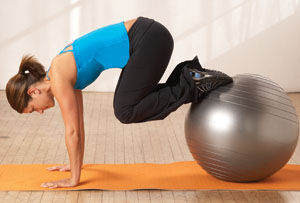
By Chris Freytag
The adrenaline is pumping and participants are sweating as you lead them through another heart-pumping group fitness class. You look at the clock and realize it’s getting close to the last 10 minutes—time to take it to the mat and work the abs. But wait…maybe it’s time to change your mindset from “abs” to “core” and challenge your members and yourself to take the core work up off the floor.
Don’t get me wrong—I’m not advocating eliminating supine core work altogether. Not only is it effective, it is supported by many respected researchers. Dr. Len Kravitz, associate professor of exercise science at the University of New Mexico, says, “A balanced approach of spinal flexion, rotation and lateral flexion in the back-lying position is recommended. You should emphasize the involvement of all the abdominal muscle groups for abdominal shaping and low-back health reasons."
With de-conditioned individuals or those with a history of low-back pain, we should always start at stage one to learn how to activate the muscles as they have lost this reflexive ability. This would involve exercises performed on a mat, where we teach hollowing and centering or the drawing-in maneuvers as are instructed in Pilates.
However, most of your regular participants who are in good health should train their core musculature using a variety of exercises and techniques. Performing core exercises in a plank position, standing position or with the use of an unstable surface like the BOSU® or a stability ball allows you to get off your back and fight gravitational forces at the same time.
Here are three simple steps to help you bring more “core-off-the-floor” exercises into your classes.
EDUCATE
Before you start challenging your participants to work their core in all directions, you should have a thorough understanding of the core musculature.

There are four main abdominal muscles: rectus abdominis, external obliques, internal obliques and the transverse abdominis. The rectus abdominis runs vertically, flexes the core and is the crunching muscle responsible for creating the elusive six-pack. The external and internal obliques run diagonally on the side of the torso and flex the trunk forward, back and sideways, and are responsible for rotation of the trunk. The transverse abdominis is a deep muscle that runs horizontally around the body and often is referred to as the lower abs. I call it a “human girdle” that helps to secure and protect the low back while stabilizing and tightening the low belly.
The spine is comprised of 33 vertebrae, with seven vertebrae in your neck (cervical spine), 12 vertebrae in your mid back (thoracic spine), five vertebrae in your low back (lumbar spine) and nine fused vertebrae comprising the sacrum and coccyx (Figure 1). There are many back extensors and stabilizers that activate when you challenge your torso to work against gravity.
A wide variety of resources are available to help you acquire a better understanding of the core musculature and its functions. Here are a few suggestions:
Attend a continuing education course. Fitness conferences typically feature live workshops and lectures focusing on core training and anatomy. ACE also offers a functional-training workshop, which features “a five-stage progression model that starts with learning stabilization exercises and transitions all the way to working with explosive movements and exercises requiring stabilization without any support.”

Take a Pilates class. A reputable Pilates instructor will begin by teaching you core stabilization and spinal alignment, and guide you through the varying degrees of core engagement, control and coordination with varying positions.
Learn online. If you don’t have the time to get to a class, online training courses are a convenient learning option. The ACE online Continuing Education Center features several courses focusing on core training.
Sharing your understanding of anatomy with your classes can create a more focused group with better body awareness. At the beginning of every class, quickly mention the principles of core training (e.g., deep breathing to encourage core activation, proper alignment of the pelvis and torso to encourage better posture) and help them get in touch with the location of the various muscles they will be targeting in your class. This can be as simple as having participants place a hand below the belly button and then coughing. Explain that this muscle helps in forceful respiration, compresses internal organs and stabilizes the trunk, and encourage them to engage that muscle throughout the exercises.
INFUSE
In a class of 40 participants, it is difficult, if not impossible, to see or control what each person is doing. Giving accurate, clear cues and well-planned modifications throughout the class will help everyone in the room feel successful and stay safe. As you become more comfortable with cueing the movements, you will be able to interject pelvic positioning, postural cues and abdominal engagement tips throughout the class. Core work shouldn’t be relegated to the last 10 minutes of class. Instead, it is up to you to use your knowledge to create opportunities to introduce core work throughout the entire class.
For instance, in a cardio class such as kickboxing or cycling, focus on stabilization. In a cycling class, have participants practice hinging forward at the hip flexors while placing as little weight on the handles and arms as possible. Tell them to engage their transverse abdominis to keep their trunk stable and strong. Keep cueing pelvic placement and core engagement throughout the ride. In a kickboxing class, the core is intimately involved in almost every move. Talk about it during kicks. Focus on it during uppercuts. Keep it at the forefront of their minds during all the moves so that they learn to replace momentum with stabilization. If you are teaching a strength-based class with equipment, the possibilities are endless. For instance, instead of a traditional mid-back dumbbell row, perform mid-back rows or alternating mid-back rows from a plank or kneeling plank position. Or instead of performing long-arm front raises from a standing position, try a high kneeling position. By removing the help of the lower body, the shoulders and abdominals must work harder to lift the dumbbells. And remember that tools such as the BOSU and stability ball help promote core activators due to their unstable surfaces.
PREPARE
When introducing new moves, an outline can help. Even after 20 years of teaching, I still write down any new moves I plan to use in class and place the list on the stereo next to me. In this way, new ideas and specific words that will help me cue modifications are close at hand if I need them. And, as we have discussed in previous articles, the highest form of flattery is copying the moves of another instructor, so watch your peers, visit a new club or attend a conference. Take notes so you don’t have to rely on an overworked memory to recall all the new moves during your next class. I teach at national fitness conferences and I get many follow-up e-mails from attendees asking me to review an exercise or concept I taught in my class. I don’t mind repeating and helping my peers.
Download the PDF to the right for eight of my favorite core-off-the-floor exercises to help you get started.
Conclusion
Joseph Pilates once said, “It’s what you can’t see that matters most.” Core engagement is not always visible to the eye in a sea of members sweating in a dimmed studio. But your participants will benefit from your continuous teaching of the principles of core engagement, on and off the floor. And, because we spend most of our day in an upright position, participants will begin to realize that they can and should activate the core anywhere and at anytime to strengthen their muscles, improve their posture and provide adequate support to the spine.
___________________________________________________________________
 Chris Freytag is a health and fitness expert, blogger, author and motivational speaker, and is an ACE-certified GFI, PT and LWMC. She is a contributing editor for Prevention; the creator of the 10 Pound Slim Down Xtreme; fitness contributor for the NBC affiliate in Minneapolis; and Chairman of the Board of Directors for the American Council on Exercise. Connect with Chris at www.chrisfreytag.com.
Chris Freytag is a health and fitness expert, blogger, author and motivational speaker, and is an ACE-certified GFI, PT and LWMC. She is a contributing editor for Prevention; the creator of the 10 Pound Slim Down Xtreme; fitness contributor for the NBC affiliate in Minneapolis; and Chairman of the Board of Directors for the American Council on Exercise. Connect with Chris at www.chrisfreytag.com.